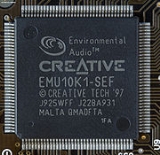
Sound Blaster Live!
Encyclopedia
Sound Blaster Live! is a sound card
from Creative Technology
. It is a PCI
add-on board for PCs
.
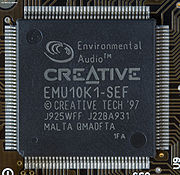
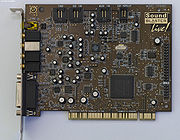
 Sound Blaster Live! (August 1998) saw the introduction of the EMU10K1 processor, a 2.44 million transistor audio DSP, rated at 1000 MIPS. The EMU10K1 featured hardware acceleration for DirectSound
Sound Blaster Live! (August 1998) saw the introduction of the EMU10K1 processor, a 2.44 million transistor audio DSP, rated at 1000 MIPS. The EMU10K1 featured hardware acceleration for DirectSound
and EAX 1.0 and 2.0 (environmental audio extensions
), a high-quality 64-voice MIDI sample-based synthesizer
, and an integrated FX8010
DSP
chip for real-time digital audio effects.
A major design change from its predecessor (the EMU8000) was that the EMU10K1 used system memory, accessed over the PCI
bus, for the wavetable samples, rather than using expensive on-board memory. This was possible at this point because systems were being equipped with far more RAM than previously, and PCI offered far faster and more efficient data transfer than the old ISA
bus.
The integrated FX8010 was a 32-bit programmable processor with 1 KB of instruction memory. It provided real-time postprocessing effects (such as reverb
, flanging
, or chorus
). DSP effects in the older SB/AWE family were restricted to MIDI synth, but in the SB/Live family, the EMU10K1's integrated FX8010 operated on any source. This capability let users select a pre-defined listening environment from a control-panel application (concert hall, theater, headphones, etc.) It also provided hardware-acceleration for EAX, Creative's environmental audio technology. The Effect algorithms were created by a development system that integrated into Microsoft Developer Studio. The effects were written in a language similar to C
, and compiled into native FX8010 object code by its compiler, fxasm.
The Sound Blaster Live! featured higher audio quality than previous Sound Blasters, as it processed the sound digitally at every stage, and because of its greater chip integration that reduced the analog signal losses of older, larger cards. Unfortunately, digital processing brought some limitations. The DSP had an internal fixed sample rate of 48 kHz, a standard AC'97 clock, meaning that the EMU10K1 always captured external audio-sources at the 48 kHz, then performed a sample-rate conversion on the 48 kHz waveform to the output the requested target rate (such as 44.1 kHz or 32 kHz). This rate-conversion step introduced IM distortion into the downsampled output. The SB/Live had great difficulty with resampling audio-CD source material (44.1 kHz) without introducing audible distortion. Creative addressed this concern by recommending audio-recording be performed exclusively at 48 kHz, and use third-party software to handle the desired sample-rate conversion, to avoid using the EMU10K1's sample-rate conversion.
Sound Blaster Live! supported multi-speaker output, initially up to a 4-speaker setup. The software referred to this as a "4.1" setup, meaning 4 satellites and a subwoofer
. While this is the case, the subwoofer is not on a separate output as it is with 5.1 and higher audio. Instead, a low-pass filter
(crossover) within the speaker system removes high and midrange frequencies from the sound card's output for the subwoofer. Games see a "4.1" speaker system as quadraphonic
because DirectSound itself offers no subwoofer output in this configuration. http://groups.google.com/group/microsoft.public.win32.programmer.directx/browse_thread/thread/d07cf88a9f1373b9 This is not limited to Creative sound cards; Aureal, Ensoniq
, Philips
, and other manufacturers have made cards that use four-speaker output in the same fashion. Later versions of the Live!, usually called Live! 5.1, offered 5.1-channel support which adds a center-channel speaker and LFE subwoofer output, most useful for movie watching where Dolby Digital
5.1 is decoded.
The Live! implemented DOS
legacy support via Ensoniq
's AudioPCI DOS TSR
program. Creative acquired Ensoniq in 1998 and, as part of the deal, made use of this highly-compatible ISA
sound card emulator with their newer cards. In fact, the Live! uses ".ecw" (Ensoniq Concert Wavetable) files for the wavetable emulation in DOS. The program enables support for many standards, such as Sound Blaster 16, General MIDI
, AdLib
(OPL3), among others.
Sound Blaster Live! was the first sound card from Creative with the "What U Hear" recording input channel. This was supported in the Windows drivers, so no additional software was needed to utilize it. The analog stereo audio signal that came out of the main Line Out was directed into this input. That way, one could mix all available inputs and the MIDI synth into one stereo signal. When using "What U Hear" with 5.1 sound, the sound would be downmixed to stereo first.
The rear channel was serviced by a separate, but arguably better Philips UDA1334 DAC, yet the Op-Amp used to boost the signal to output levels had a noticeably different frequency response envelope that was not normalized to the front channel, leaving a "thin and quiet" rear channel. To make matters worse, the rear channel Op-Amp was of the inverting variety without being treated as such, leaving the rear speakers out of phase with the front, requiring switchover. These problems were not encountered by those using the Gold editions' daughterboard 4-speaker digital-output, but the tendency of the AC'97 chip to fail when used as an input source to medium-impedance musical instruments removed the use of the front channels altogether, although the chip could be sourced from cheaper AC'97 compatible products and soldered into place. Nevertheless, simply redirecting front signal to rear output of SB Live! was for a long time a favorite trick for computer audio enthusiasts who want better sound for minimum of money.
Despite these problems, the original SB Live! can still be used well as a S/P-DIF input/output and MIDI input/output device for network-connected digital audio workstation environments.
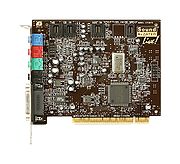 The Live! and Live! Value are the original releases of the Live! family.
The Live! and Live! Value are the original releases of the Live! family.
The Live! Value (also known as Live! 1024) is identical to the full Live! with the exception that it has color coded plastic connectors instead of gold and does not include the extended digital I/O card. The original Sound Blaster Live! had a proprietary 9-pin mini-DIN connector
for digital output that Creative referred to as the "Mini Din." This connector allowed the use of a microphone and digital speakers at the same time. This cannot be done with the value and base models of all subsequent Creative sound cards, as they share a single port for S/PDIF digital in/output and microphone connectivity. The Mini-DIN connection was not included in any subsequent Sound Blaster product, however owners of speaker systems that use this as the only digital input may buy an adapter from Creative.
Unfortunately the card is not supported by Windows Vista
unless running the sound in the 5.1 surround sound setting. .
An outside party has release free drivers for the sound card here: http://kxproject.lugosoft.com/
For details on the original Live! including the Gold edition, marketing strategy, and design faults, see Sound Blaster Live! (Original)
speaker and LFE subwoofer channel.
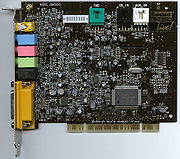 This card, marketed as a Sound Blaster Live!, did not have the full capabilities of the retail versions of Live! It used a different audio chip, not EMU10K1 but EMU10K1X, that is noticeably smaller with fewer pins. The chip does not accelerate DirectSound in hardware, nor EAX. The sale of this board by Dell created some controversy because it was not obviously marketed as an inferior or cheaper product. The card can be identified by its part number (SB0200/0203). http://forums.us.dell.com/supportforums/board/message?board.id=dim_audio&message.id=39953
This card, marketed as a Sound Blaster Live!, did not have the full capabilities of the retail versions of Live! It used a different audio chip, not EMU10K1 but EMU10K1X, that is noticeably smaller with fewer pins. The chip does not accelerate DirectSound in hardware, nor EAX. The sale of this board by Dell created some controversy because it was not obviously marketed as an inferior or cheaper product. The card can be identified by its part number (SB0200/0203). http://forums.us.dell.com/supportforums/board/message?board.id=dim_audio&message.id=39953
operating systems, when using the ALSA sound system, the module that is used for the Sound Blaster Live! 24-bit is snd-ca0106, while the module that is used by the Sound Blaster Live! is snd-emu10k1.
and developed the EMU10K1 chip featured on its Live! family. It featured professional functions
such as effects with higher quality, front mounted drive bay panel with headphone output, double mic/line inputs with physical level control knobs, digital coax in/out on both pci card and drive bay, exclusively looking mixer with dB precision, phantom power for microphones (12V), ASIO, mixer presets, internal mixer rerouting, 64 midi channels, 32MB system RAM usage for SF2 (Gigabyte expandable in WinXP), future expandability through an extra Multi-Out Card. It also featured line in and line out; all analogue inputs and outputs were balanced quarter-inch/6.3mm TRS jacks.
http://www.soundonsound.com/sos/jan99/articles/emuaudio.000.htm
http://www.retrosampling.se/emuaps/emuaps.htm
Sound card
A sound card is an internal computer expansion card that facilitates the input and output of audio signals to and from a computer under control of computer programs. The term sound card is also applied to external audio interfaces that use software to generate sound, as opposed to using hardware...
from Creative Technology
Creative Technology
Creative Technology Ltd. is a Singapore-based global company headquartered in Jurong East, Singapore. The principal activities of the company and its subsidiaries consist of the design, manufacture and distribution of digitized sound and video boards, computers and related multimedia, and personal...
. It is a PCI
Peripheral Component Interconnect
Conventional PCI is a computer bus for attaching hardware devices in a computer...
add-on board for PCs
IBM PC compatible
IBM PC compatible computers are those generally similar to the original IBM PC, XT, and AT. Such computers used to be referred to as PC clones, or IBM clones since they almost exactly duplicated all the significant features of the PC architecture, facilitated by various manufacturers' ability to...
.
Overview



DirectSound
DirectSound is a software component of the Microsoft DirectX library for the Windows operating system. DirectSound provides a low-latency interface to the sound card driver and can handle the mixing and recording of multiple audio streams....
and EAX 1.0 and 2.0 (environmental audio extensions
Environmental audio extensions
The environmental audio extensions are a number of digital signal processing presets for audio, present in Creative Technology's later Sound Blaster sound cards and the Creative NOMAD/Creative ZEN product lines...
), a high-quality 64-voice MIDI sample-based synthesizer
Sample-based synthesis
Sample-based synthesis is a form of audio synthesis that can be contrasted to either subtractive synthesis or additive synthesis. The principal difference with sample-based synthesis is that the seed waveforms are sampled sounds or instruments instead of fundamental waveforms such as the saw waves...
, and an integrated FX8010
FX8010
The FX8010, is a DSP architecture, designed for realtime audio effects, designed by E-mu, around their EMU10K1 chip. One key feature of the architecture, is not providing any branching instructions, but rather running the whole program in a sample locked constant loop, ie a constant number of...
DSP
Digital signal processor
A digital signal processor is a specialized microprocessor with an architecture optimized for the fast operational needs of digital signal processing.-Typical characteristics:...
chip for real-time digital audio effects.
A major design change from its predecessor (the EMU8000) was that the EMU10K1 used system memory, accessed over the PCI
Peripheral Component Interconnect
Conventional PCI is a computer bus for attaching hardware devices in a computer...
bus, for the wavetable samples, rather than using expensive on-board memory. This was possible at this point because systems were being equipped with far more RAM than previously, and PCI offered far faster and more efficient data transfer than the old ISA
Industry Standard Architecture
Industry Standard Architecture is a computer bus standard for IBM PC compatible computers introduced with the IBM Personal Computer to support its Intel 8088 microprocessor's 8-bit external data bus and extended to 16 bits for the IBM Personal Computer/AT's Intel 80286 processor...
bus.
The integrated FX8010 was a 32-bit programmable processor with 1 KB of instruction memory. It provided real-time postprocessing effects (such as reverb
Reverberation
Reverberation is the persistence of sound in a particular space after the original sound is removed. A reverberation, or reverb, is created when a sound is produced in an enclosed space causing a large number of echoes to build up and then slowly decay as the sound is absorbed by the walls and air...
, flanging
Flanging
Flanging is an audio effect produced by mixing two identical signals together, with one signal delayed by a small and gradually changing period, usually smaller than 20 milliseconds. This produces a swept comb filter effect: peaks and notches are produced in the resultant frequency spectrum,...
, or chorus
Chorus effect
In music, a chorus effect occurs when individual sounds with roughly the same timbre and nearly the same pitch converge and are perceived as one...
). DSP effects in the older SB/AWE family were restricted to MIDI synth, but in the SB/Live family, the EMU10K1's integrated FX8010 operated on any source. This capability let users select a pre-defined listening environment from a control-panel application (concert hall, theater, headphones, etc.) It also provided hardware-acceleration for EAX, Creative's environmental audio technology. The Effect algorithms were created by a development system that integrated into Microsoft Developer Studio. The effects were written in a language similar to C
C (programming language)
C is a general-purpose computer programming language developed between 1969 and 1973 by Dennis Ritchie at the Bell Telephone Laboratories for use with the Unix operating system....
, and compiled into native FX8010 object code by its compiler, fxasm.
The Sound Blaster Live! featured higher audio quality than previous Sound Blasters, as it processed the sound digitally at every stage, and because of its greater chip integration that reduced the analog signal losses of older, larger cards. Unfortunately, digital processing brought some limitations. The DSP had an internal fixed sample rate of 48 kHz, a standard AC'97 clock, meaning that the EMU10K1 always captured external audio-sources at the 48 kHz, then performed a sample-rate conversion on the 48 kHz waveform to the output the requested target rate (such as 44.1 kHz or 32 kHz). This rate-conversion step introduced IM distortion into the downsampled output. The SB/Live had great difficulty with resampling audio-CD source material (44.1 kHz) without introducing audible distortion. Creative addressed this concern by recommending audio-recording be performed exclusively at 48 kHz, and use third-party software to handle the desired sample-rate conversion, to avoid using the EMU10K1's sample-rate conversion.
Sound Blaster Live! supported multi-speaker output, initially up to a 4-speaker setup. The software referred to this as a "4.1" setup, meaning 4 satellites and a subwoofer
Subwoofer
A subwoofer is a woofer, or a complete loudspeaker, which is dedicated to the reproduction of low-pitched audio frequencies known as the "bass". The typical frequency range for a subwoofer is about 20–200 Hz for consumer products, below 100 Hz for professional live sound, and below...
. While this is the case, the subwoofer is not on a separate output as it is with 5.1 and higher audio. Instead, a low-pass filter
Low-pass filter
A low-pass filter is an electronic filter that passes low-frequency signals but attenuates signals with frequencies higher than the cutoff frequency. The actual amount of attenuation for each frequency varies from filter to filter. It is sometimes called a high-cut filter, or treble cut filter...
(crossover) within the speaker system removes high and midrange frequencies from the sound card's output for the subwoofer. Games see a "4.1" speaker system as quadraphonic
Quadraphonic
Quadraphonic sound – the most widely used early term for what is now called 4.0 surround sound – uses four channels in which speakers are positioned at the four corners of the listening space, reproducing signals that are independent of one another...
because DirectSound itself offers no subwoofer output in this configuration. http://groups.google.com/group/microsoft.public.win32.programmer.directx/browse_thread/thread/d07cf88a9f1373b9 This is not limited to Creative sound cards; Aureal, Ensoniq
Ensoniq
Ensoniq Corp. was an American electronics manufacturer, best known throughout the mid 1980s and 1990s for its musical instruments, principally samplers and synthesizers.- Company history :...
, Philips
Philips
Koninklijke Philips Electronics N.V. , more commonly known as Philips, is a multinational Dutch electronics company....
, and other manufacturers have made cards that use four-speaker output in the same fashion. Later versions of the Live!, usually called Live! 5.1, offered 5.1-channel support which adds a center-channel speaker and LFE subwoofer output, most useful for movie watching where Dolby Digital
Dolby Digital
Dolby Digital is the name for audio compression technologies developed by Dolby Laboratories. It was originally called Dolby Stereo Digital until 1994. Except for Dolby TrueHD, the audio compression is lossy. The first use of Dolby Digital was to provide digital sound in cinemas from 35mm film prints...
5.1 is decoded.
The Live! implemented DOS
DOS
DOS, short for "Disk Operating System", is an acronym for several closely related operating systems that dominated the IBM PC compatible market between 1981 and 1995, or until about 2000 if one includes the partially DOS-based Microsoft Windows versions 95, 98, and Millennium Edition.Related...
legacy support via Ensoniq
Ensoniq
Ensoniq Corp. was an American electronics manufacturer, best known throughout the mid 1980s and 1990s for its musical instruments, principally samplers and synthesizers.- Company history :...
's AudioPCI DOS TSR
Terminate and Stay Resident
Terminate and Stay Resident is a computer system call in DOS computer operating systems that returns control to the system as if the program has quit, but keeps the program in memory...
program. Creative acquired Ensoniq in 1998 and, as part of the deal, made use of this highly-compatible ISA
Industry Standard Architecture
Industry Standard Architecture is a computer bus standard for IBM PC compatible computers introduced with the IBM Personal Computer to support its Intel 8088 microprocessor's 8-bit external data bus and extended to 16 bits for the IBM Personal Computer/AT's Intel 80286 processor...
sound card emulator with their newer cards. In fact, the Live! uses ".ecw" (Ensoniq Concert Wavetable) files for the wavetable emulation in DOS. The program enables support for many standards, such as Sound Blaster 16, General MIDI
General MIDI
General MIDI or GM is a standardized specification for music synthesizers that respond to MIDI messages. GM was developed by the MIDI Manufacturers Association and the Japan MIDI Standards Committee and first published in 1991...
, AdLib
AdLib
Ad Lib, Inc. was a manufacturer of sound cards and other computer equipment founded by Martin Prevel, a former professor of music and vice-dean of the music department at the Université Laval...
(OPL3), among others.
Sound Blaster Live! was the first sound card from Creative with the "What U Hear" recording input channel. This was supported in the Windows drivers, so no additional software was needed to utilize it. The analog stereo audio signal that came out of the main Line Out was directed into this input. That way, one could mix all available inputs and the MIDI synth into one stereo signal. When using "What U Hear" with 5.1 sound, the sound would be downmixed to stereo first.
Design Shortcomings
The original SB Live! had a very low noise floor for its time; however, a critical design flaw limited its application in quadraphonic audio. The two S/P-DIF channels that each provided a stereo pair differed in their Digital to Analog reconstruction. Since the AC'97 chip provided an internal 48 kHz DAC, Creative chose not to implement two identical DAC pipelines, and the front-speaker audio pair was subjected to a different reconstruction and amplification regime to that of the rear channel (as evidenced by differently valued pull-up resistors and filter-capacitors in the area forward of the AC'97 chip, in the specifications of the AC'97 itself, and in the use of different amplifier Op-Amps).The rear channel was serviced by a separate, but arguably better Philips UDA1334 DAC, yet the Op-Amp used to boost the signal to output levels had a noticeably different frequency response envelope that was not normalized to the front channel, leaving a "thin and quiet" rear channel. To make matters worse, the rear channel Op-Amp was of the inverting variety without being treated as such, leaving the rear speakers out of phase with the front, requiring switchover. These problems were not encountered by those using the Gold editions' daughterboard 4-speaker digital-output, but the tendency of the AC'97 chip to fail when used as an input source to medium-impedance musical instruments removed the use of the front channels altogether, although the chip could be sourced from cheaper AC'97 compatible products and soldered into place. Nevertheless, simply redirecting front signal to rear output of SB Live! was for a long time a favorite trick for computer audio enthusiasts who want better sound for minimum of money.
Despite these problems, the original SB Live! can still be used well as a S/P-DIF input/output and MIDI input/output device for network-connected digital audio workstation environments.
Sound Blaster Live! and Live! Value

The Live! Value (also known as Live! 1024) is identical to the full Live! with the exception that it has color coded plastic connectors instead of gold and does not include the extended digital I/O card. The original Sound Blaster Live! had a proprietary 9-pin mini-DIN connector
Mini-DIN connector
The mini-DIN connectors are a family of multi-pin electrical connectors used in a variety of applications. Mini-DIN is similar to the larger, older DIN connector...
for digital output that Creative referred to as the "Mini Din." This connector allowed the use of a microphone and digital speakers at the same time. This cannot be done with the value and base models of all subsequent Creative sound cards, as they share a single port for S/PDIF digital in/output and microphone connectivity. The Mini-DIN connection was not included in any subsequent Sound Blaster product, however owners of speaker systems that use this as the only digital input may buy an adapter from Creative.
Unfortunately the card is not supported by Windows Vista
Windows Vista
Windows Vista is an operating system released in several variations developed by Microsoft for use on personal computers, including home and business desktops, laptops, tablet PCs, and media center PCs...
unless running the sound in the 5.1 surround sound setting. .
An outside party has release free drivers for the sound card here: http://kxproject.lugosoft.com/
For details on the original Live! including the Gold edition, marketing strategy, and design faults, see Sound Blaster Live! (Original)
Sound Blaster Live! Platinum
Released 1999 http://www.creative.com/soundblaster/milestones/1990-1999.asp Includes Live! Drive IRSound Blaster Live! 5.1 and Sound Blaster Live! Platinum 5.1
Released 2000. http://www.creative.com/soundblaster/milestones/2000-2001.asp Live! with added outputs for a center channelCenter channel
Center channel refers to an audio channel common to many surround sound formats. It is the channel that is mostly, or fully, dedicated to the reproduction of the dialogue of an audiovisual program...
speaker and LFE subwoofer channel.
Sound Blaster Live! Dell OEM

Sound Blaster Live! 5.1 Digital (Dell OEM, SB0220)
This was a later, improved model. The EMU10K1 chip was put back, as was hardware EAX/DirectSound/DirectSound3D acceleration. Nowadays there are working Windows drivers available for download from Creative's website (filename LiveDrvUni-Pack_ENG_.exe). It was recommended somewhere that all recording should be done in 48 kHz sampling rate, because there was an issue with hardware downsampling.Sound Blaster Live! 24-bit
The Sound Blaster Live! 24-bit (SB0410) was not actually a member of the Sound Blaster Live! family, because it lacked the EMU10k1/10k2 processor. It was a stripped down version of the Audigy Value, with an SNR of 100 dB, software based EAX, no advanced resolution DVD-Audio Playback, and no Dolby Digital 5.1 or Dolby Digital EX 6.1 playback. A proof of this is that on LinuxLinux
Linux is a Unix-like computer operating system assembled under the model of free and open source software development and distribution. The defining component of any Linux system is the Linux kernel, an operating system kernel first released October 5, 1991 by Linus Torvalds...
operating systems, when using the ALSA sound system, the module that is used for the Sound Blaster Live! 24-bit is snd-ca0106, while the module that is used by the Sound Blaster Live! is snd-emu10k1.
EMU APS (Audio Production Studio)
This was a professional version but under E-mu production line, E-mu were owned by Creativeand developed the EMU10K1 chip featured on its Live! family. It featured professional functions
such as effects with higher quality, front mounted drive bay panel with headphone output, double mic/line inputs with physical level control knobs, digital coax in/out on both pci card and drive bay, exclusively looking mixer with dB precision, phantom power for microphones (12V), ASIO, mixer presets, internal mixer rerouting, 64 midi channels, 32MB system RAM usage for SF2 (Gigabyte expandable in WinXP), future expandability through an extra Multi-Out Card. It also featured line in and line out; all analogue inputs and outputs were balanced quarter-inch/6.3mm TRS jacks.
http://www.soundonsound.com/sos/jan99/articles/emuaudio.000.htm
http://www.retrosampling.se/emuaps/emuaps.htm
External links
- The kX Audio Driver is an independent WDMWindows Driver ModelIn computing, the Windows Driver Model — also known at one point as the Win32 Driver Model — is a framework for device drivers that was introduced with Windows 98 and Windows 2000 to replace VxD, which was used on older versions of Windows such as Windows 95 and Windows 3.1, as well...
driver for all EMU10K1 and EMU10K2-based soundcards. - The ASIO4all Driver is another independent driver.
- GeorgeBreese.com there is a low-level Patch needed in order to repair crackling/stuttering sound for VIA chipset-based machines.
- File Forum is a source for old drivers, some of which are no longer available on the Creative Labs support webpage.

